Decoupage is a very popular and interesting technique that allows you to transform many things, and often give them a new life. Thus make out a variety of objects and designs. It can be furniture, kitchen utensils, and different decorations, and caskets - you can list for a very long time. Today we will take a closer look at the technique called volumetric decoupage and find out what its distinguishing features are.
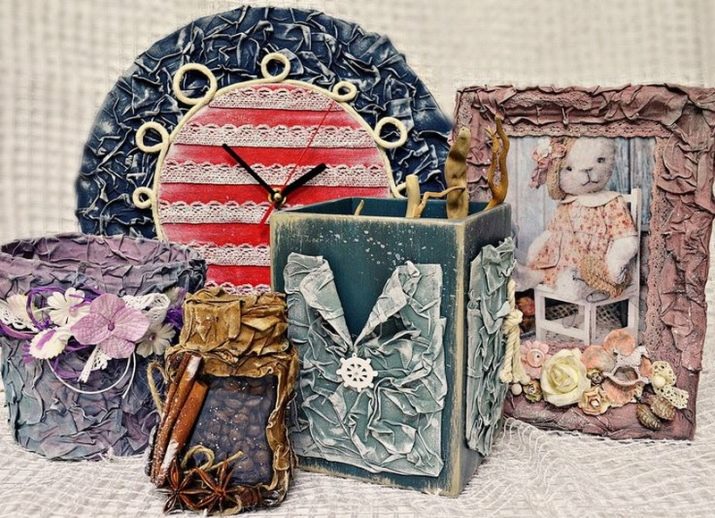
Features of the technique
Everyone wants their home to look aesthetically pleasing, and to be in it as comfortable as possible. It is possible to achieve this desired goal if due attention is paid to creating a harmonious and beautiful interior. Often for this lack of some zest or fresh solution. This is where the decoupage technique comes to the rescue.
Thanks to decoupage, it is possible not only to make the atmosphere more interesting and original, but also to give old furniture or accessories an attractive appearance. There are several varieties of this type of decorating items. One of the most unusual and eye-catching is considered the so-called volumetric decoupage.
This is a very popular manual cutting and sculpting technique. to create spectacular three-dimensional compositions. For the manufacture of unusual decorations, materials such as paper and bulk texture paste are most often used.


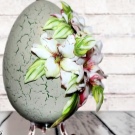



On the part of the work carried out in such a technique can seem very complex and intricate. In fact, an inexperienced beginner can execute them.The main thing is to consider in detail at least a couple of master classes, which will explain in detail how to properly make such decorations.
A beautiful and three-dimensional image in 3D should be in three main levels:
- background;
- intermediate;
- top or front.



As soon as the decoration is ready at all specified levels, on properly executed decoupage you need to apply high-quality varnish. Similar processing should be subjected to each section of the product. If such decoupage is done for a vintage setting, then varnish, of course, should not be used. To enhance the volumetric effect of such decoupage will be possible with the help of a frame. Such options are also called in-depth.


Properly executed volumetric decoupage is able to attract a lot of attention. Such a detail in the setting can play the role of a bright accent, which cannot be overlooked. But not only in the interior, this technique is used. Often, volumetric decoupage can be found on original postcards.
Necessary materials and tools
Before embarking on an independent production of a unique decoration in the technique of volumetric decoupage, you need to stock up on all the necessary tools and materials. Both must be high quality and reliable.

If the condition and quality of these components make you suspicious, then it is better to refuse to buy, otherwise you may not get the best result at the end.
And now we’ll highlight a list of all the necessary components required to make a beautiful surround decoupage:
- identical beautiful napkins with clear and pronounced borders, not too dull motives;
- high-quality acrylic paints;
- sponge made of foam rubber;
- sandpaper (it is advisable to use fine-grained options);
- special glue for decoupage;
- acrylic varnish with a glossy effect;
- scissors and brushes;
- special molding mass with a self-hardening effect;
- devices necessary for correct and convenient modeling (special stack for modeling or a toothpick);
- plastic board designed for modeling;
- penknife or scalpel (you can use a disposable tool);
- tweezers;
- high-density white paper or white cardboard;
- pen or pencil;
- thermal film;
- putty;
- penoplex.

Perhaps some of the listed “ingredients” will not be useful to you, but it is advisable to have them in your arsenal so as not to encounter the lack of the necessary details.
General recommendations
Volumetric decoupage looks interesting and original. Well-made 3D elements can be made, if not only clearly follow the detailed instructions, but also take into account some recommendations from experienced masters.
- You can make volumetric decoupage without spending a lot of effort and free time. The main thing is to conduct preparatory procedures correctly. First of all, you will need to carefully consider the future composition and think over all the elements that you plan to give volume to.
- It is important to consider that very small parts are difficult to make voluminous.
- It is necessary to prepare all the necessary tools and materials in advance so as not to waste extra time searching for them.
- In the work you need to use only fairly thick paper. Too thin leaflets, as a rule, are torn during all the necessary manipulations.
- It is not recommended to use silicone glue, because acetic acid is present in its composition. It can seep into the deep layers of thick paper.
- It is recommended to choose acrylic varnish on a water basis. He will give the composition a more spectacular and aesthetic appearance.
- To create bright and voluminous elements, they often use a special paste, which is based on such a component as clay. At the time of drying, it becomes similar to snow-white ceramics.
- 3D can be done with the introduction of eggshells.


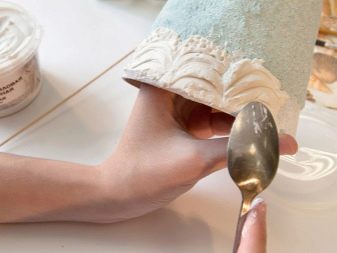
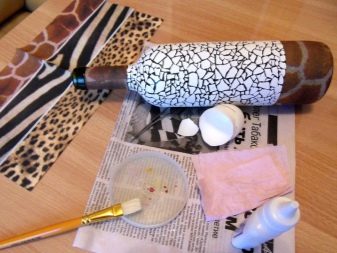
Workshops for beginners
It is possible to create a beautiful volumetric decoupage with your own hands, but for this it is recommended to rely on master classes or detailed instructions. Moreover, experienced masters and beginners can cope with similar tasks. Let's consider step by step some interesting workshops on making original 3D compositions.

Using the volume decoupage technique, you can make a very simple, but cute and beautiful decoration with a charming hedgehog. The sequence of actions here will be as follows:
- first, you will need to carefully cut out all the necessary details of the drawing (details of the hedgehog and flowers);
- cut out the necessary motives, and then begin to give the hedgehog needles extra volume;
- provide the images with the desired shape;
- glue components on top of each other - from the largest to the smallest.



Volume will be given to images through a consistent technique of sticking images. When the whole composition is glued in a high-quality and reliable manner, its certain details should be carefully treated with a high-quality varnish, designed specifically for decoupage. Try to carry out such work as carefully and consistently as possible.
A very beautiful and expressive 3D decoupage is obtained by gluing the eggshell. Here the procedure is as follows:
- prepare the shell - it must be absolutely clean and dry;
- as a decor item, it is permissible to take a plastic jar, and then gently paint it in 2 layers with acrylic paint;
- process the can with putty;
- on the walls of the jar, apply an adhesive composition for decoupage (special) or an ordinary PVA solution;
- using tweezers, glue small pieces of eggshell to the prepared and greased base;
- coat the already glued jar with a repeated adhesive layer;
- leave the jar for a while so that it is completely dry;
- at this time, you should carefully cut out the planned images you like (maybe anything - flowers, animals, angels, patterns, and so on) from popular three-layer napkins; instead of the latter, it is permissible to use special decoupage cards;
- process the jar with light acrylic varnish;
- then glue the top layer of the cut out pictures on the base.
- pictures on such an object will be able to provide additional volume using acrylic paints of different shades.





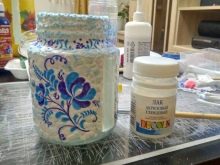
At the end of these manipulations, you will need to process the beautiful composition with varnish. The latter can be stacked in one or in two layers. It is advisable to use a special varnish designed specifically for decoupage here.
Volumetric decoupage made using special paste looks unusual and attractive. Here you can take a bottle as a basis. The procedure will be as follows:
- first, on a perfectly clean surface of the bottle, you need to transfer acrylic paint of a light range;
- Now the walls of the bottle must be primed, and it is advisable to use several layers of a coloring composition for this;
- remember that a new coat of primer can be applied only after the previous one has completely dried out;
- then it will be necessary to prepare all the necessary decorative components;
- cut out the planned drawings from multilayer napkins, carefully separate the topmost layer of the picture from the other two;
- stick pictures on the base bottle;
- apply acrylic varnish in light tones;
- Now, in accordance with the contours of the glued drawings, you need to carefully apply a specialized structural paste;
- to transfer the paste to the base, you can put into the case a syringe or a medical pear;
- then all the walls of the bottle should be covered again with light paint on an acrylic base and carefully varnished.




Very elegant and “expensive” in appearance decoupage of the bottle can be done using pieces of cloth. The latter can be any. Cotton, silk, velvet, chintz, and other high-quality options are also suitable. Let's analyze the phased steps:
- remove all labels and stickers from the bottle, and with them dust and dirt;
- degrease the bottle with alcohol wipe;
- prepare the adhesive - dilute the PVA glue with water;
- prepare a piece of fabric of the required size;
- gently dip the textiles into the prepared adhesive solution;
- Now transfer the glue to the bottle itself;
- gently distribute textiles on the surface of the bottle, forming an aesthetic drapery;
- allow time for the fabric to dry out a bit;
- process textile parts with acrylic paints;
- Now apply a special varnish for decoupage on the decorated base.

Useful Tips
For volume decoupage you need to choose paper very carefully. It was stated above that it should not be too thin. But too tight options should also not be used.
If you still do not have rich experience in the manufacture of such crafts, then you should not immediately take on very complex objects. It is better to start with simpler and more understandable options, clearly following all the instructions.

The working surfaces of the bases are always recommended to be treated with a snow-white coloring composition, since against such a light background the pattern will look much brighter and more expressive.
Try to apply a primer and paint not too thick layers. Layers should be thin. This rule is explained by the fact that only in this case will it be possible to evenly process the entire surface of the subject.

According to experts, It’s best to start with small details that are not so bad to spoil. Drawings should always be smoothed in such a way that there are no bubbles on them.

See how to make surround decoupage in the next video.










